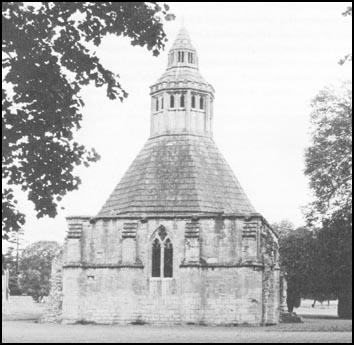Glastonbury
A monastery was built at Glastonbury in the seventh century. In 1125 William of Malmesbury visited the area while researching a book on the history of England. He afterwards argued that as well as Edgar Atheling and Edmund Ironside, several other important people were buried at Glastonbury including King Arthur, St. Patrick and St. David. He also claimed that the relics of Benedict Biscop, St. Aiden, St. Dunston and St. Paulinus were also at the monastery. This claim was rejected by the monks of Canterbury who claimed they had most of these remains at their shrine.
On 25th May, 1184, everything at Glastonbury, except for the Bell Tower, was destroyed by fire. Henry II immediately arranged for rebuilding the abbey and the old church at Glastonbury. Soon afterwards the monks at Glastonbury claimed they found King Arthur's tomb. This was reported by Gerald of Wales and Glastonbury soon became an important place for pilgrims to visit. By the end of the 13th century the religious shrine brought in about £120 a year.
In September 1539 Henry VIII gave instructions for Glastonbury to be closed down. As well as the confiscation of the shrine's wealth, Richard Whyting, the 80 year-old abbot of Glastonbury was hung, drawn and quartered. The four parts of his body was divided between Wells, Bath, Ilchester and Bridgwater.

Primary Sources
(1) Sidney Heath, Pilgrim Life in the Middle Ages (1911)
From very early days Glastonbury was considered a sacred spot, for here King Arthur was buried. The first church is said to have been a little wattled building erected by St. Joseph, but the early ecclesiastical history of the place is very obscure, although two early charters mention the little wooden church, the forerunner of the famous monastery.
In the sixth century St. David is reputed to have built a new church near the old one, and still later King Ina built and endowed a monastery. After the Danish invasions the foundation declined, but was brought into prominence again by St. Dunstan, who caused Glastonbury to become famous throughout Europe for its culture and learning, and whose spurious shrine in later days attracted thousands of pilgrims.
(2) D. J. Hall, English Medieval Pilgrimage (1965)
With Glastonbury alone remaining in Somerset, and the sight of desecration, dismantling and homeless monks in all the country round, Whyting knew the end was near. By an act of April 1539 the king was empowered to take over any monastery by reason of attainder of treason. This was needed to give legal colour, for, in the case of a great abbey such as Glastonbury refusing to surrender, no law empowered its seizure. Already, though, the abbey had been relieved of its 'superfluous plate', including the great sapphire of Glastonbury, a superaltar garnished with silver and part gold. That year the abbot did not attend parliament, awaiting the inevitable at home.
In September the visitors returned, this time with no pretence but that of confirming the abbot's 'cankered and traitorous mind'. This done, the eighty-year-old abbot, 'a very weak man and sickly', was sent forthwith to the Tower. Nothing shows more clearly the king's and Cromwell's preoccupation than the letters sent by the Visitors which speak of little but the items of money, gold and plate which they are collecting. Soon Cromwell could list 'The plate of Glastonbury, 11,000 ounces and over, besides golden'.
